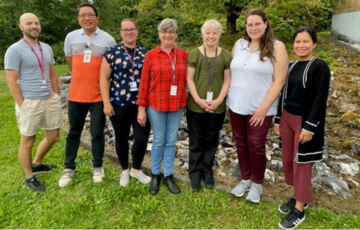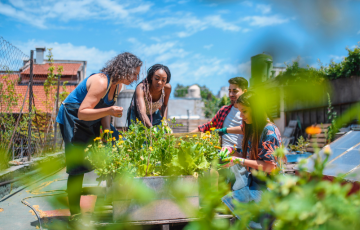The Island Health PPH Healthy Communities program advances community health and well-being throughout the Island Health region by working together to improve child, youth and family wellness, promoting community development, and engaging in evidence-informed best practices and education.
The Healthy Communities program supports a wide range of community-based initiatives, programs and events to support health promotion and injury prevention. In collaboration with community and school partners, the team supports alignment with Island Health areas of priority and local community health priorities. The program also supports Community Health Networks, Island Food Security Hubs, and administers two grant programs (Youth Resilience, Vision Zero Road Safety).
Established in January 2023, the Healthy Communities program has four teams that carry out various health promotion activities across the island:
- Public Health Dietitians – Food and Nutrition team
- School Health Promoters – Healthy Schools team
- Community Health Promoters – Community Development team
- Injury Prevention Specialists – Injury Prevention team
Healthy Communities Foundational Concepts
Vision
The Island Health PPH Healthy Communities program supports community-driven efforts to foster healthy people in flourishing communities.
Guiding principles
Health equity: Considerations of the determinants of health, prioritization based on health inequities, and advocacy through healthy public policy.
Cultural humility: Respecting and developing reflexive practices for cultural differences, particularly when engaging with Indigenous communities, and to invite meaningful participation and decision-making as determined by community.
Community engagement: Empowering communities to take ownership of their health and wellness initiatives, by leveraging support and resources to lead sustainable efforts and support the wellbeing of future generations.
Defining Healthy Communities
A healthy community grows stronger when people, organizations, and sectors work together. Each community’s unique characteristics – its culture, history, and values – impact everyone’s well-being.
Our program partners with communities to support the determinants of health including housing, food security, climate and environment, physical activity, and more.
A healthy community exists through the efforts of many people, organizations, and sectors working together. There isn’t a single definition of a healthy community, as each one has its own unique traits and history of supporting collective health and well-being.
Healthy communities are places where people:
- Have access to the resources and opportunities that support their basic needs and physical, mental, cultural, and social well-being.
- Can reach their full potential.
- Work together to improve life for everyone.
- Embrace diversity and foster a sense of belonging.
- Consider resiliency, sustainability, and needs of future generations in their decision-making.
Healthy Communities Program
Key Goals: What We Do
- Goal 1
-
Child, youth and family wellness: To provide ongoing support to healthy schools and families to promote a thriving, healthy population in school and family communities.
- Goal 2
-
Community development: To reduce health inequities and promote healthier, more resilient communities through a community-led, collaborative approach.
- Goal 3
-
Promotion of evidence-informed best practices, education and healthy public policy: To contribute knowledge and resources to shape current guidelines, build capacity in knowledge for those supporting young minds, and identify opportunities for healthy public policy creation and revision.
- Alignment & Frameworks that Guide our Work
-
BC Public Health Guiding Framework Island Health Strategic Framework, Outcome Goal #25 Island Health Population and Public Health Strategic Goals 2023-2028 Various Chief Medical Health Officer Reports Various BC Ministry of Health Mandate letters Prevention and Health Promotion Policy Advisory Committee (PHPPAC) Healthy Schools BC Working Group Healthy Communities Provincial Working Group
- Additional Resources
-



